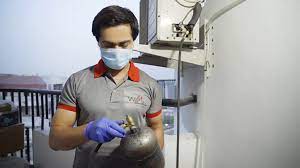Gas charging is an essential maintenance procedure for your air conditioner that helps you optimise its cooling performance. This involves adding or replenishing refrigerant gas in the AC system to ensure efficient heat exchange and proper cooling. While gas charging should be performed only by a qualified AC Engineer/Technician, it’s helpful to understand the step-by-step process involved. In this blog, we will provide you with a comprehensive guide of Professional AC Gas Charging process for your AC System.
Professional AC Gas Charging Process- Step By Step Procedure Explanation
Step-1: Assessing Refrigerant Level:
When it comes to keeping your AC running smoothly, one of the most important steps is ensuring that the refrigerant levels are adequate. This is where gas charging comes in. To assess the refrigerant levels in your system, the technician will use specialized tools to measure the pressure and temperature. These readings provide valuable information about whether the refrigerant levels are too low and whether charging is required. By taking this step, you can help ensure that your air conditioner is functioning at its best and that you are getting the most out of your investment in home comfort.


Step-2: Identifying Leaks:
Before charging the AC system with gas, it’s crucial to check for any potential leaks. These leaks can cause a refrigerant loss, leading to ineffective cooling. A skilled technician will be responsible for inspecting all AC components like pipes, fittings, & valves, using a leak detection tool. In case they discover any leaks, they will repair them before proceeding with charging the system with gas. Identifying any leaks before gas charging is a necessary step to ensure the proper functioning of the AC system. This precautionary measure guarantees that the system will work efficiently and provide the cooling needed for optimal comfort.
Also Read: 10 Myths About AC Gas Filling Debunked
Step-3: Refrigerant Removal From The HVAC System:
The AC Gas charging process is a complicated process, that ensures optimum performance of your AC unit. To start with, it’s important to evacuate the AC system before charging it with gas. This is done using a vacuum pump, which removes any existing refrigerant, moisture, and contaminants from the system. By doing so, you can be assured of a clean and efficient charging process that will not only improve the performance of your AC system but also increase its longevity. Without proper evacuation, the performance of the AC system may be affected, and you may have to deal with costly repairs in the future.
Step 4: Adding Refrigerant Gas:
After removing the gas from the system, the technician will cautiously connect the refrigerant cylinder to the AC system through suitable hoses and gauges. The refrigerant gas will be progressively introduced into the system while carefully monitoring the pressure and temperature readings to ensure optimal performance. It’s worth noting that the amount of refrigerant added will vary depending on the manufacturer’s specifications, as each AC system has its unique requirements. It’s crucial to follow the manufacturer’s guidelines to ensure that the AC system operates at maximum efficiency and provides the desired level of cooling. Overall, the process of adding refrigerant to an AC system requires precision and attention to detail.
Step 5: Checking for Optimal Performance:
Upon performing the AC Gas Charging Process, a professional AC Engineer will take a thorough check your AC system to ensure that it is working optimally. Their primary concern will be to make sure that the refrigerant levels are where they should be, as this is critical to the AC system’s proper functioning. The technician will also check that the cooling is efficient, which will help to ensure that the air coming out of the vents is cool and refreshing. Finally, they may conduct a temperature differential check across the evaporator and condenser coils to make sure that everything is working as it should.
Step 6: Sealing and Testing:
Upon completing the Professional AC Gas Charging Process, the technician will take necessary measures to avoid any refrigerant leaks by sealing the AC system. It is important to ensure that the AC unit is functioning properly and delivering the optimal cooling output. To achieve this, the technician will thoroughly test your AC unit and check the airflow, temperature control, and overall performance. This step is crucial as it not only ensures that the AC unit is operating efficiently. But it also helps them identify any underlying issues that may cause problems in the future. By taking these precautionary measures, the technician ensures that the AC performs optimally and provides a comfortable indoor environment.
Bottom Line of Professional AC Gas Charging Process
Gas charging is an essential aspect of maintaining the cooling efficiency of your air conditioner. This critical maintenance procedure is performed by qualified technicians who have a thorough understanding of the step-by-step process. However, it is also essential for homeowners to have a basic understanding of the process. This can help them identify any potential issues and communicate effectively with the technician. The process involves assessing refrigerant levels, identifying leaks, evacuating the system, and adding refrigerant as needed. Proper gas charging can significantly improve your AC’s performance & lifespan.



